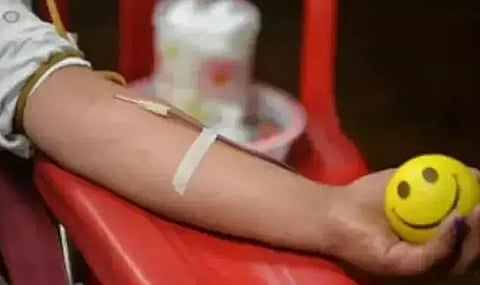
- Home
- Live Blog
- Breaking News
- Top Headlines
- Cities
- NE News
- Sentinel Media
- Sports
- Education
- Jobs

The "National Estimation of Blood Requirement of India" brought to light that if 3.43% of eligible population donates blood then adequate volume of blood will be available to meet clinical demand. It was found during the estimation that about 3.13% of the eligible persons donate blood in India which indicates that the clinical demand can be fully met with intensification of the campaign on importance of blood donation. The devil is in the details and utilization of collected blood is a key determinant of actual availability of blood for safe and sufficient transfusion. The National AIDS Control Organization (NACO), U.S. Centers for Disease Control and Prevention (CDC), New Delhi, National Institute of Medical Statistics, India, Christian Medical College, Vellore, and Christian Medical Association of India which came out with the national estimation as part of a joint study carried out in 2018, estimated the clinical demand to be 14.6 million units of blood which is required to address the demand that arises in healthcare facilities across the country. The study indicated that there should be 62.3 donations per 1,000 eligible population (6.23% of the eligible population) in a year to address the population need; 34.3 per 1000 eligible population (3.43% of the eligible population) should donate blood to address the clinical demand. The supply (the donations) was 31.9 per 1,000 eligible population (3.19% of the eligible population). The report defines the clinical demand for blood as the total number of units of whole blood and components requested or demanded to meet all blood transfusion for emergencies and elective procedures at a defined number of health facilities over one year. If the reported annual collection was considered as supply, the actual supply per 1,000 population was 26.2 per 1,000 eligible population which indicates a significant gap between demand and supply, explains the report about actual volume available for transfusion and gap that needs to be bridged. The supply was found to be 13.5 million; however, the annual collection reported by NACO (National AIDS Control Organisation) in the country was 11.1 million units in 2017, states the report which highlights the final estimation of actual supply. It says that the overall utilisation rate was found to be above 96% for whole blood and components "which seem to be an acceptablerate of utilization" but added that it is essential to understand the reasons for non-utilisation andmechanism for return and discard of blood.The report laid emphasis on policy makers, programme managers, providers of blood being aware of "the quantum of blood required to address the population need and clinical demand besides, the actual supply and utilisation." It was estimated in the study that considering available beds as reference, the country needs to collect 20.3 units of whole blood per occupied bed to address the population need and 11.17 units of whole blood per occupied bed to address the clinical demand in a year, which will be sufficient to manage the whole blood and component requirements considering the current rate of componentseparation. The National Blood Transfusion Council guidelines say that any healthy adult, both men and women, can donate blood. While men can donate blood every three months, women can donate every four months. The study estimated the population need of blood on basis of mathematical modelling using data on population at risk, prevalence or incidences of diseases or conditions, percentage of people who needs transfusion and quantum of blood components such as plasma, platelets, Red Blood Cells, albumin. The national estimation found that among the diseases or conditions that contribute to population need nutritional anaemia contributed around 39% followed byoncological conditions (21.3%), Gastrointestinal bleeding (12.9%), haemolytic anaemia (8.2%), end-stage renaldisease (8.1%), bone marrow transplant(2.5%), plasmapheresis (1.9%) and leukemia(1.6%) of total 10.6 million units of blood required to address requirement of whole blood and components. The quantum of blood required in the country to address surgical needs of population and to cater to the obstetrics and gynaecology need and paediatric need were estimated at 6.6 lakh units, 3.6 million units and 5.6 million units. This presents a larger picture in the country and calls for more and more voluntary blood donation not just on a single day of campaign but in a sustained manner to save lives of many who need to undergo surgeries, ensure adequate blood for treatment of patient with chronic and serious ailment and every single patient who requires blood transfusion. It is important to note a recommendation made in the study that not just the quantum of donors or donation, making blood accessible and available at the point of demand is most critical. Apart from spreading the WHO message that donating blood is an act of solidarity, the World Blood Donor Day is a reminder to assess the country's demand and collection of blood.